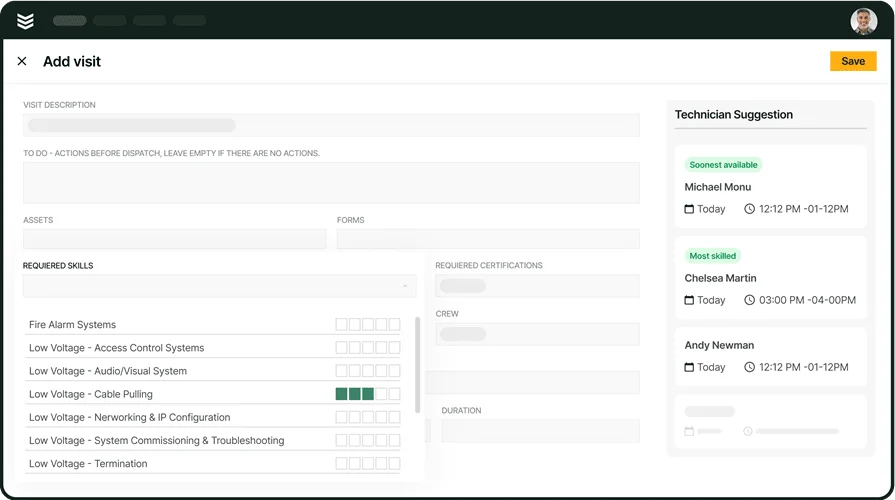Important
While BuildOps does not currently offer an electrical load calculation software, we’re always looking into new and exciting tools and technology that are moving the industry forward, which is why we’re discussing the subject here.
If you're working in the electrical industry, precise load calculations can make or break a project. Too often, teams rely on outdated spreadsheets or manual math that slow down jobs and open the door for costly mistakes. Electrical load calculation software changes that. It gives your crew the tools to calculate panel loads, balance circuits, and meet NEC standards—without wasting hours on paperwork.
For contractors already managing installs, retrofits, or system expansions, having reliable electrical load calculation software in your toolkit means fewer inspection issues and quicker project turnaround. It fits right into how today’s commercial electricians operate, especially those already exploring better field service solutions for the electrical industry. Here’s what we’ll cover:
- Choosing the right electrical load calculation software for your team
- 5 key features to look for in electrical load calculation software
- 5 top electrical load calculation software tools for contractors
- 7 benefits of using an electrical load calculation software
- 4 common electrical load calculation software FAQs answered
Before jumping into tools and features, it’s worth asking the tough questions: What’s your crew’s workflow? Do you need code compliance built in? How critical is offline access? In the next section, we’ll cover what you should be thinking through before choosing a software that fits the way your team actually works.
Choosing the right electrical load calculation software for your team
Every commercial electrical project has its own unique demands—load requirements, panel configurations, inspection codes. The wrong tool can slow down your crew or cause costly missteps. That’s why finding the best electrical load calculation software starts with figuring out how your team actually works.
Before you dive into downloads or demos, it helps to ask the questions that matter on-site and in the office. Below are key areas to think through as you evaluate which electrical load calculation app will actually help your crew do their job better—not just add another layer of admin work.
- Project scope and job type – Does your team mostly handle new builds, retrofits, or ongoing service work? Are most of your jobs small-scale or multi-phase commercial installs? Do you need support for load centers, branch circuits, or transformer calculations?
- Team workflow – Are your electricians used to working off tablets, phones, or laptops? Will multiple team members be using the software in the field and the office? Do you need shared access or sync across devices?
- Code compliance and safety – Do you regularly need to reference NEC standards or local codes? Is the crew running into issues with AHJ inspections tied to load accuracy? Could auto-calculations reduce errors and callbacks?
- Time and resource pressure – Are jobs getting delayed because load calculations are done manually? Is your estimator or lead tech spending too much time reviewing basic math? Would a tool with auto-fill or saved templates help you move faster?
- Features – Does the software calculate single-phase and three-phase loads? Can it handle multiple panels and connected systems? Does it generate reports that are useful for plan reviewers or city inspectors?
Choosing the best electrical load calculation software isn’t about chasing bells and whistles—it’s about giving your crew the power to work smarter, faster, and safer. Up next, we’ll break down the top features to look for in a commercial electrical load calculation software so you can sort through what really matters in the field.
5 key features to look for in electrical load calculation software
Electrical contractors deal with enough complexity on the job. Software should simplify, not slow things down. Whether you're working in the field or reviewing plans in the office, electrical load calculation software should help your team stay accurate, efficient, and inspection-ready.
These five features make a real difference in how fast and cleanly your crew can get work done—especially on commercial projects where the load demand is anything but basic.
1. NEC auto-calculations that run in the background
No more flipping through codebooks or second-guessing inputs. Software should automatically apply NEC rules—covering load types, service sizes, demand factors, and derating—all while you're entering data. It keeps your designs compliant without slowing down the workflow, so inspections go smoother and revisions drop off your radar.
2. Offline access built for field use
Jobsites don’t always have perfect signals. Your load calculation software needs to work even when the Wi-Fi or LTE doesn’t. Crews should be able to access panel data, make changes, and save updates offline. When back online, everything should sync without a hitch. For all-in-one visibility, pair it with a field service technician mobile app that also manages service logs, parts tracking, or scheduling.
3. Real-time sync between office and crew
When a foreman updates load values in the field, your estimator back at the shop should see those changes immediately. Real-time syncing avoids version mix-ups and wasted time. Whether it’s an update to a feeder calculation or a subpanel layout tweak, both sides of the team stay on the same page without calls or emails.
4. Full control over panel schedules and load breakdowns
Basic calculators stop at totals. Electrical pros need tools that drill into subpanels, circuits, and load groups. The software should let you organize loads by room, zone, or system and generate panel schedules you can print or share digitally. That’s especially useful when planning large commercial retrofits or multi-tenant installs.
5. Downloadable reports that back up your work
Quick math isn’t enough—you need clean documentation for AHJs, clients, or engineers. Top-tier software will let you export reports showing panel schedules, NEC references, and load summaries. If you already use a reporting tool, having your load data flow straight into those docs saves even more time when wrapping up a job or submitting for approval.
Other valuable features to have in an electrical load calculation software
Electrical load calculation software should do more than calculate amps and voltage drops. For commercial teams especially, it has to fit into a bigger workflow—quoting jobs, assigning techs, tracking hours, handling contracts, and getting paid. While these tools aren’t technically part of the load calculations, they matter when you're trying to run a smooth operation across multiple jobsites.
Here are a few additional features that round out the best software setups.
- Scheduling and job assignment – Managing multiple installs across different buildings takes structure. Built-in scheduling tools help assign jobs based on availability, prevent overlap, and keep projects moving when plans shift. Techs can get updates in real-time so no one’s left guessing what’s next.
- Quoting tools for electrical service – Before a load ever gets calculated, you need client approval. With quoting software, your team can generate quick quotes based on estimated labor, parts, and panel configurations—and send them from the field. Faster sign-offs mean you can start sooner.
- Recurring contract management – For ongoing service work or scheduled upgrades, you’ll want the software to support recurring agreements. A solid service agreement platform helps track which sites need what work and when, auto-generates tickets, and keeps you ahead of your maintenance timelines.
- Time entry and crew tracking – Techs should be able to clock in and out of jobs right from the app. Good time tracking tools log hours automatically, tie them to specific jobs, and sync with payroll—cutting down admin time.
- Invoicing and mobile payment support – Once the job wraps, billing shouldn’t slow you down. Integrated invoicing tools turn job data into invoices in just a few taps. Pair that with a payment solution that lets customers pay on-site or online, and you’ve got a clean handoff from field to office.
Strong electrical load calculation software doesn’t stop at numbers. The more connected it is to the rest of your workflow, the faster your team moves—and the smoother each job runs. Next, we’ll look at the best electrical load calculation software options out there for commercial contractors.
5 top electrical load calculation software tools for contractors
Finding the right electrical load calculation software can make or break how fast your team gets from planning to inspection. Some tools are made for quick residential calcs, others for complex commercial specs—but not all of them are built with electricians in the field in mind. Here's a closer look at five top tools that help contractors get the job done with less guesswork and more confidence.
1. Best for commercial: BuildOps
BuildOps provides a powerful all-in-one field service management platform tailored for commercial electrical contractors who handle rapid field operations. Although BuildOps doesn't offer electrical load calculation software at this time, its service management suite provides essential tools for electrical professionals to manage their daily operations—including quotes, scheduling, service agreements, dispatch, time tracking, invoicing, and reporting—all in one integrated platform.
How pricing works: Custom pricing based on company size and feature needs. Includes platform setup and onboarding.
Features beyond load calculation: Service quoting and proposal tools, technician scheduling and dispatch, service agreement tracking, CRM software, invoicing & payments solutions, and technician performance reporting.
What sets it apart for commercial: BuildOps is a platform designed for commercial electrical service businesses with numerous field technicians and maintenance agreements. It streamlines operations by consolidating all essential tools for service electricians in one place.

Curious how BuildOps works?
Manage your daily electrical service operations—all from one unified platform.
2. Best for residential: Kopperfield Load Calculator
Image Source: Kopperfield
Kopperfield’s load calculator is a lightweight electrical load calculation software designed for residential electricians who need to produce NEC-compliant load results quickly. It’s user-friendly, focused on single-family home installs, and comes with features like basic form generation and printable reports—ideal for panel upgrades and service changeouts. That said, it may not be the best fit for commercial contractors who need multi-panel support or deeper circuit customization.
How pricing works: Free to use, with optional upgrades as part of the full Kopperfield platform.
Features beyond load calculation: Users can generate PDFs, export project data, and use simple proposal templates to support permitting and customer approvals.
What sets it apart for residential: The strength here is speed. Electricians can run complete residential load calcs and print a permit-ready doc within minutes—perfect for teams focused on quick code checks and efficient approvals.
3. Best for general contractors: Osmose
Image Source: Osmose
Osmose offers electrical load calculation software that suits general contractors needing simple load tools baked into broader utility and infrastructure workflows. It's especially useful for teams working on mixed-scope projects that include electrical assessments along with structural and utility inspections. However, this tool may not be the most practical for crews focused exclusively on service-based electrical contracting.
How pricing works: Pricing is typically custom, based on scope of project use and licensing terms.
Features beyond load calculation: Osmose includes GIS integration, field data collection, and asset inspection modules—blending electrical calculations with infrastructure management tools.
What sets it apart for general contractors: It’s built to support multi-discipline field operations, helping project managers handle electrical inputs alongside other engineering data from the same platform. This makes it a solid choice for contractors working in utilities or large infrastructure projects.
4. Best for electrical design calculators: Elek
Image Source: Elek
Elek is an advanced calculator-style software aimed at electrical designers and engineers who require detailed pre-construction analysis. The tool supports load calculations, voltage drop checks, and breaker sizing—all wrapped in a code-referenced interface. It’s less suited for live field work, which might make it a weaker option for service contractors needing speed and flexibility on the job.
How pricing works: Elek offers tiered license-based pricing starting around $49, depending on feature access.
Features beyond load calculation: The software includes full conductor sizing, derating adjustments, voltage loss tracking, and CAD export support for integration into electrical drawings.
What sets it apart for design work: Elek shines in pre-build planning and design validation. It’s ideal for those who need in-depth calculations to spec out an entire system before the first wire is pulled.
5. Best for electrical installations: Trace Software
Image Source: Trace
Trace Software provides comprehensive electrical calculation software built for engineers and electricians focused on installations across commercial and industrial projects. It handles complex circuit architecture, load flow, and protection settings, with tools designed for high-compliance environments. That depth can be overkill for smaller crews focused only on load calculations or day-to-day service work.
How pricing works: Quote-based licensing depending on user count, project type, and included modules.
Features beyond load calculation: Offers automated diagrams, energy efficiency modeling, protective device coordination, and simulation-based verification for high-voltage systems.
What sets it apart for installations: Trace is geared toward professionals managing detailed design-build installations, especially where power distribution, redundancy, and safety systems need to be simulated and validated before install. It's a powerhouse for code-heavy, multi-system builds.

Get the Electrical Contractor Toolkit
Get tips and strategies on how to run a business as an electrical contractor.
7 benefits of using an electrical load calculation software
Electrical contractors deal with tight timelines, code compliance, and project complexity—every day. Electrical load calculation software gives your team a real way to cut through the noise. These tools aren’t just for code checks; they help crews move faster, reduce rework, and build trust with clients. Here’s how the right software pays off on and off the jobsite.
1. Faster job turnaround
Manual calculations slow things down. With electrical load calculation software, your team can calculate, validate, and export everything in a fraction of the time. This kind of speed keeps field schedules tight and opens the door for same-day permits or faster inspections—especially when paired with electrical dispatch tools that help crews respond and adapt in real-time.
2. Improved accuracy and fewer inspection issues
Wrong numbers lead to failed inspections. Software that handles NEC logic and applies code updates automatically reduces human error and keeps you compliant. When your field reports and submitted calcs match inspection expectations, your pass rate climbs—saving return trips and lost labor.
3. Cleaner collaboration between field and office
Whether it’s the estimator in the office or the lead tech on-site, everyone needs access to the same load data. Good software keeps updates synced and ensures there’s no confusion between what was calculated and what’s being built. That kind of alignment becomes even stronger when tied into electrical contractor project management platforms that track job phases and progress across teams.
4. Mobile-ready for in-field adjustments
Jobsite conditions change. Having electrical load calculation software that runs on mobile means your techs can make real-time updates without heading back to the truck or calling in to the office. For crews already working from tablets or phones, this mobility matters. Check out how electrical load calculation apps support field conditions without compromising accuracy.
5. Easier documentation and digital reporting
Permit departments want clean, readable reports. Load calculation software creates exportable files that include panel schedules, demand summaries, and NEC references. When connected to your invoicing system, this data can roll straight into closeout docs or client billing—see how that ties into this electrical contractor invoicing guide to keep paperwork tight and on-brand.
6. Smarter customer communication
When your load calcs are stored and sharable, clients can get quick answers without waiting for callbacks. This transparency builds trust—especially when tied into your electrical contractor CRM to track correspondence, approvals, and follow-up opportunities tied to the job.
7. Better use of your team’s time
Automating load calculations frees up senior techs and project managers to focus on design, quality control, or client communication instead of crunching numbers. Whether it’s saving hours per job or reducing post-inspection corrections, the time saved adds up fast—especially across large-scale or repeat commercial work.
4 common electrical load calculation software FAQs answered
Electrical load calculation software helps electrical contractors simplify code-heavy tasks, eliminate manual math, and improve jobsite efficiency. It brings speed, accuracy, and compliance together in one tool—especially valuable for commercial teams handling complex panel configurations or NEC requirements.
1. What is electrical load calculation software?
Electrical load calculation software is a digital tool that automates the process of determining the total electrical load for a system being worked on, applying NEC standards to calculate current demand from lighting, appliances, equipment, and circuits to ensure safe and compliant installations.
It’s used to size panels, feeders, and breakers accurately while reducing the chance of code violations. This software helps electrical contractors replace handwritten worksheets and outdated spreadsheets with real-time results they can trust in both the field and office.
2. How does electrical load calculation software work?
These platforms walk users through a series of inputs like service size, circuit count, load types, and demand factors. As the data is entered, the software calculates totals and applies NEC code logic to produce accurate load schedules. Many tools also include features like offline access, mobile compatibility, and real-time syncing. Teams can generate panel schedules, export permit-ready reports, and collaborate across roles—streamlining both installs and inspections.
3. Is electrical load calculation software worth the cost for contractors?
Yes. For contractors regularly dealing with installs, retrofits, or multi-panel systems, the time savings alone justify the cost. When inspections are passed on the first attempt and rework is reduced, project timelines stay intact and crews stay focused. Aside from labor savings, it adds professionalism to your process. Whether you’re working on a bid, submitting to the city, or showing clients the scope of work, a clean digital report backed by accurate calcs makes a strong impression.
4. Best practices for implementing electrical load calculation software
Getting started with load calculation software isn’t complicated, but a few best practices can make it smoother for your whole team:
- Define who on the team is responsible for entering and reviewing calculations
- Make sure the tool aligns with NEC requirements relevant to your region
- Start with a small project or retrofit to train the team without pressure
- Enable mobile access so field techs can run calculations without calling the office
- Set up templates for recurring load types or panel configurations
- Sync the software with project folders or job tracking tools where possible
- Use exported reports to support inspection submissions and closeout packages
- Revisit your setup quarterly to update any custom rules, templates, or NEC changes
Solid implementation upfront helps you get the full benefit of the tool without slowing down the jobsite.
Wrapping up, electrical load calculation software gives commercial electricians the tools to do their work with precision, speed, and confidence. Whether it’s passing inspections the first time, keeping field teams aligned, or generating reports that make sense to clients and city reviewers alike—these tools cut down the chaos and bring structure to the job. And while many platforms offer bits and pieces, most don’t tie everything together in one system.
That’s where BuildOps comes in. While we don’t currently offer a load calculator, everything else your service team needs—from quoting and dispatch to invoicing and reporting—lives in one place. It's a single platform built around the real workflows of commercial electrical contractors, helping you connect the field and office without the usual gaps.

Take a closer look at BuildOps
We keep electrical crews aligned so they can keep jobs on track.








